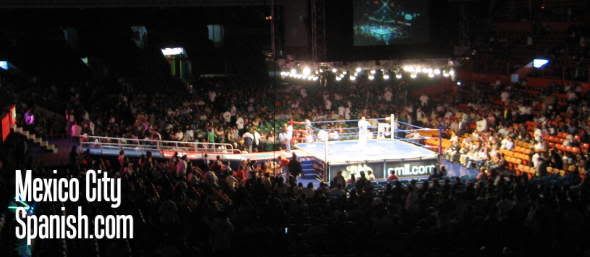Lucha Libre in Historic Arena México

If, while walking about the streets of Mexico City, you encounter boys, girls or even adults wearing brightly-colored masks covering their entire heads, never fear. You haven't come across a color-coordinated bank robber or street gang - a religious expression may more accurately describe this choice of vestment - Welcome to the church of Lucha Libre.
Blasphemous analogies aside, Lucha Libre is the biggest sport in Mexico behind soccer. Literally 'Free Fight', Lucha Libre is the equivalent of professional wrestling in the United States, although most followers would argue that the reverse is actually true (and may have the history to back them up.) Part sport, part acrobatic act, part soap opera, Lucha Libre generates a mass and constant appeal in Mexico with weekly television broadcasts and events.
The best way to watch a match is to see it in person, where Spanish students in Mexico City can take in the culture of this very-Mexican form of entertainment - from small children dressed head to toe as their favorite Luchador, to their abuelitas sitting next to them shouting curses to the bad guys and blowing kisses to the good guys -- people of all ages enjoy the event.
And the only place to watch a match is in historic Arena México, the holy temple of Luchadores. The 16,000 + seat area, constructed in 1933, is host to the promotion company Consejo Mundial de Lucha Libre, CMLL, the oldest professional wresting promoter still in existence. The founder of the CMLL, Salvador Lutterroth Gonzales, is considered the father of Mexican Lucha Libre.
A typical match on Friday night will have 4-5 individual fights, consisting of 2-3 rounds each. The popularity and skill of the fighters will increase each round until the final, or headliner match. Luchadores work in teams of 2 or 3, and of course the good guys versus the bad guys, or Técnicos (meaning technician, as in using standard fighting form and playing by the rules) versus rudos (the crude ones, the heels). It's up to you as to who you want to root for.
A relatively new attraction is the exotico lucha libre, a Luchador portrayed as an effeminate or 'gay' fighter who torments his opponents by grabbing butts or stealing kisses. Luchadores such as Maximo, who sports a pink mohawk and is assisted by a little person who dresses in a blue bear suit and carries a near life-sized doll of himself, have developed considerable fanbases.
The main headliners draw enormous followings in Mexico and have entered mainstream advertising, sponsoring everything from toothpaste, to candy bars, to their own lines of clothing. Many luchadores take on political causes, supporting worker's and children's rights.
The greatest luchador of all, El Santo, is considered to be the most popular figure in Mexican sports. El Santo's transformation from luchador into popular Mexican cultural icon began in the early 1950's with the Santo comic book. That lead to a movie role featuring Santo, masked of course, and the legend was born. El Santo starred in over 50 movies overall, including Santo vs. the Evil Brain, Santo vs. The Vampire Women, and Santo vs. Frankenstein’s Daughter. When Santo passed in 1984, it was reported that he was buried in his mask.
Two of the unique features of Mexican professional wrestling are the use of masks and high flying acrobatic moves. The aerial maneuvers alone are worth the price of admission. The skill of individual luchadores is evident when they jump over or even through the ropes to land on opponents outside of the ring. While the fights themselves may be less than authentic, the jumps, dives and falls are real, and should be appreciated even by the casual observer.
The masks have been claimed to have historical significance, with Aztec warriors wearing colored masks or headdresses to distinguish themselves. Many masked luchadores are able to maintain the character outside the ring, giving interviews or appearing in public wearing the mask with street clothes. This also allows some wrestlers to maintain a bit of anonymity in a country where their sport, and personas, are so popular.
Of course, if you find your self wanting to have at least some part of the action, you can by a mask of your favorite fighter outside the arena, and wear it with pride.